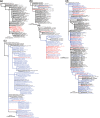Inter-Seasonal Influenza is Characterized by Extended Virus Transmission and Persistence
- PMID: 26107631
- PMCID: PMC4479464
- DOI: 10.1371/journal.ppat.1004991
Inter-Seasonal Influenza is Characterized by Extended Virus Transmission and Persistence
Abstract
The factors that determine the characteristic seasonality of influenza remain enigmatic. Current models predict that occurrences of influenza outside the normal surveillance season within a temperate region largely reflect the importation of viruses from the alternate hemisphere or from equatorial regions in Asia. To help reveal the drivers of seasonality we investigated the origins and evolution of influenza viruses sampled during inter-seasonal periods in Australia. To this end we conducted an expansive phylogenetic analysis of 9912, 3804, and 3941 hemagglutinnin (HA) sequences from influenza A/H1N1pdm, A/H3N2, and B, respectively, collected globally during the period 2009-2014. Of the 1475 viruses sampled from Australia, 396 (26.8% of Australian, or 2.2% of global set) were sampled outside the monitored temperate influenza surveillance season (1 May - 31 October). Notably, rather than simply reflecting short-lived importations of virus from global localities with higher influenza prevalence, we documented a variety of more complex inter-seasonal transmission patterns including "stragglers" from the preceding season and "heralds" of the forthcoming season, and which included viruses sampled from clearly temperate regions within Australia. We also provide evidence for the persistence of influenza B virus between epidemic seasons, in which transmission of a viral lineage begins in one season and continues throughout the inter-seasonal period into the following season. Strikingly, a disproportionately high number of inter-seasonal influenza transmission events occurred in tropical and subtropical regions of Australia, providing further evidence that climate plays an important role in shaping patterns of influenza seasonality.
Conflict of interest statement
The authors have declared that no competing interests exist.
Figures




Similar articles
-
Predominance of influenza A(H3N2) viruses during the 2016/2017 season in Bulgaria.J Med Microbiol. 2018 Feb;67(2):228-239. doi: 10.1099/jmm.0.000668. Epub 2018 Jan 3. J Med Microbiol. 2018. PMID: 29297852
-
Update: Influenza Activity - United States and Worldwide, May 20-October 13, 2018.MMWR Morb Mortal Wkly Rep. 2018 Oct 26;67(42):1178-1185. doi: 10.15585/mmwr.mm6742a3. MMWR Morb Mortal Wkly Rep. 2018. PMID: 30359347 Free PMC article.
-
Unseasonal transmission of H3N2 influenza A virus during the swine-origin H1N1 pandemic.J Virol. 2010 Jun;84(11):5715-8. doi: 10.1128/JVI.00018-10. Epub 2010 Mar 17. J Virol. 2010. PMID: 20237080 Free PMC article.
-
An Epidemiological Analysis of Summer Influenza Epidemics in Okinawa.Intern Med. 2016;55(24):3579-3584. doi: 10.2169/internalmedicine.55.7107. Epub 2016 Dec 15. Intern Med. 2016. PMID: 27980256 Free PMC article. Review.
-
Influenza in the tropics.Curr Opin Infect Dis. 2010 Oct;23(5):415-20. doi: 10.1097/QCO.0b013e32833cc955. Curr Opin Infect Dis. 2010. PMID: 20644472 Review.
Cited by
-
Human seasonal influenza under COVID-19 and the potential consequences of influenza lineage elimination.Nat Commun. 2022 Mar 31;13(1):1721. doi: 10.1038/s41467-022-29402-5. Nat Commun. 2022. PMID: 35361789 Free PMC article.
-
Inter-seasonality of influenza in Australia.Influenza Other Respir Viruses. 2019 Sep;13(5):459-464. doi: 10.1111/irv.12642. Epub 2019 Mar 30. Influenza Other Respir Viruses. 2019. PMID: 30929310 Free PMC article.
-
The seasonality of infections in tropical Far North Queensland, Australia: A 21-year retrospective evaluation of the seasonal patterns of six endemic pathogens.PLOS Glob Public Health. 2022 May 25;2(5):e0000506. doi: 10.1371/journal.pgph.0000506. eCollection 2022. PLOS Glob Public Health. 2022. PMID: 36962353 Free PMC article.
-
Integrating dynamical modeling and phylogeographic inference to characterize global influenza circulation.medRxiv [Preprint]. 2024 Mar 15:2024.03.14.24303719. doi: 10.1101/2024.03.14.24303719. medRxiv. 2024. Update in: PNAS Nexus. 2024 Dec 17;4(1):pgae561. doi: 10.1093/pnasnexus/pgae561. PMID: 38559244 Free PMC article. Updated. Preprint.
-
Acute Respiratory Tract Infections among Hospitalized Palestinian Patients (2011-2016): A Retrospective Study.Can J Infect Dis Med Microbiol. 2021 May 3;2021:5643134. doi: 10.1155/2021/5643134. eCollection 2021. Can J Infect Dis Med Microbiol. 2021. PMID: 34055115 Free PMC article.
References
-
- Nelson MI, Holmes EC. The evolution of epidemic influenza. Nat Rev Genet. 2007; 8: 196–205. - PubMed
Publication types
MeSH terms
LinkOut - more resources
Full Text Sources
Other Literature Sources
Medical

